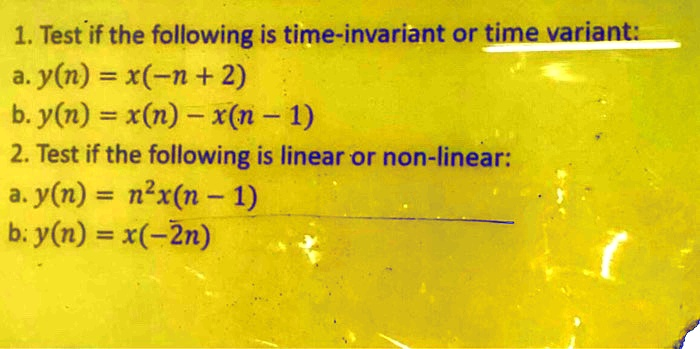Test if the following is time-invariant or time variant: a. y(n) = x(-n + 2) b. y(n) = x(n) – x(n – 1) 2. Test if the following is linear or non-linear: a. y(n) = n^2x(n – 1) b. y(n) = x(-2n)

The Correct Answer and Explanation is:
Here’s a complete analysis of the systems based on time-invariance and linearity:
1. Time-Invariance
a. y(n)=x(−n+2)y(n) = x(-n + 2)
Apply a shift n→n−n0n \rightarrow n – n_0:
y(n−n0)=x(−(n−n0)+2)=x(−n+n0+2)y(n – n_0) = x(-(n – n_0) + 2) = x(-n + n_0 + 2)
Now shift the input instead:
x′(n)=x(n−n0)⇒y′(n)=x′(−n+2)=x(−n+2−n0)x'(n) = x(n – n_0) \Rightarrow y'(n) = x'(-n + 2) = x(-n + 2 – n_0)
Since y(n−n0)≠y′(n)y(n – n_0) \ne y'(n), the system output depends on the absolute value of nn, not just the relative shift. Conclusion: Time-variant.
b. y(n)=x(n)−x(n−1)y(n) = x(n) – x(n – 1)
Shift input: x(n−n0)⇒y′(n)=x(n−n0)−x(n−n0−1)x(n – n_0) \Rightarrow y'(n) = x(n – n_0) – x(n – n_0 – 1) Now compute y(n−n0)y(n – n_0):
y(n−n0)=x(n−n0)−x(n−n0−1)y(n – n_0) = x(n – n_0) – x(n – n_0 – 1)
Both expressions match. Conclusion: Time-invariant.
2. Linearity
a. y(n)=n2x(n−1)y(n) = n^2 x(n – 1)
Let y1(n)=n2x1(n−1)y_1(n) = n^2 x_1(n – 1) and y2(n)=n2x2(n−1)y_2(n) = n^2 x_2(n – 1). Check additivity:
y(n)=n2[x1(n−1)+x2(n−1)]=y1(n)+y2(n)y(n) = n^2 [x_1(n – 1) + x_2(n – 1)] = y_1(n) + y_2(n)
Check homogeneity:
ay(n)=n2ax(n−1)ay(n) = n^2 a x(n – 1)
Both properties hold. Conclusion: Linear.
b. y(n)=x(−2n)y(n) = x(-2n)
Check additivity:
y(n)=x1(−2n)+x2(−2n)=x(−2n) for x=x1+x2y(n) = x_1(-2n) + x_2(-2n) = x(-2n) \text{ for } x = x_1 + x_2
Check homogeneity:
ay(n)=ax(−2n)a y(n) = a x(-2n)
Both properties hold. Conclusion: Linear.
Final Answers:
- 1a: Time-variant
- 1b: Time-invariant
- 2a: Linear
- 2b: Linear
